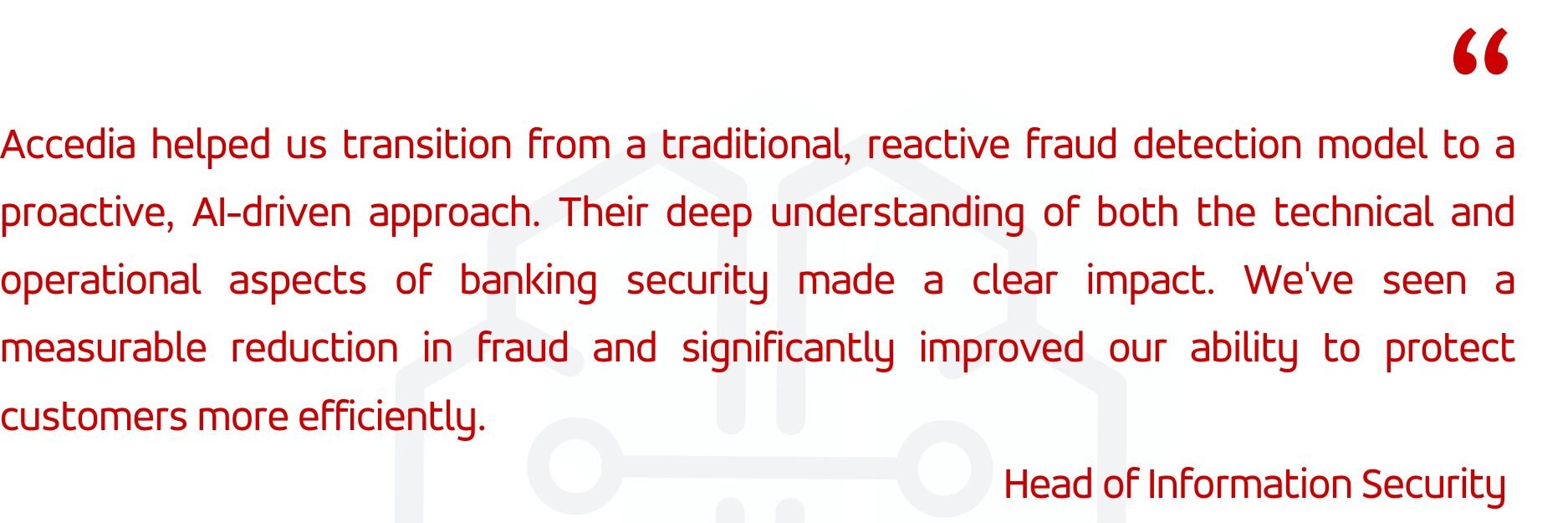How a Leading UK Bank Leveraged AI Agents for Fraud Detection?
Case Study
06.05.2025
Overview
Facing an increase in sophisticated fraudulent applications and the limitations of static fraud detection systems, a leading UK bank needed a smarter, faster solution. Their goal was to move beyond traditional defenses and create a real-time, AI-powered fraud detection layer. This would strengthen their credit decision processes without disrupting customer experience.
This case study explores how the bank partnered with Accedia to build an adaptive, cloud-based solution that reduced fraud incidents by 35% and set a new benchmark for banking cybersecurity resilience in a digital-first landscape.
Why a New Approach to Fraud Detection in Banking Was Needed
As cybercriminals adapted faster than static fraud management systems could, traditional defenses struggled to catch increasingly sophisticated applications. The bank realized that incremental improvements were no longer enough. They needed a proactive, intelligent system capable of real-time analysis, dynamic pattern recognition, and seamless integration into their automated credit decision-making processes. The goal was clear: protect customer assets, reduce financial losses, and stay ahead of both regulatory demands and the shifting landscape of cybersecurity in banking.

The Goal: Proactive Fraud Prevention, Built for Change
To close the widening gap between new fraud tactics and outdated defenses, the bank partnered with Accedia. Together, we developed a suite of autonomous AI agents that integrate seamlessly into the bank’s decisioning systems, enabling real-time threat detection, continuous learning, and minimal manual oversight.
The solution was integrated into the bank’s automated credit decision workflows, analyzing large volumes of affordability and fraud-related data from external credit bureaus and platforms. It created a new layer of real-time fraud detection, flagging potential threats that previously went undetected, and significantly reduced sunk costs associated with fraudulent applications.
How We Approached the Development Process
The project kicked off with a collaborative discovery phase. Our teams worked closely with the bank’s credit risk and IT departments to fully understand operational workflows, data structures, and regulatory compliance needs.
The development was structured into three overall phases. First, we built a proof of concept, validating AI models using historical data to demonstrate their ability to detect hidden fraud patterns. Next, we moved into full solution design, establishing scalable data pipelines and selecting machine learning algorithms tailored to the bank’s specific requirements. Finally, the solution was deployed into the production environment, with extensive testing, optimization, and compliance checks to ensure both technical robustness and operational readiness.
Throughout each phase, the focus remained on building an accurate system but also on creating a solution that could adapt effortlessly to the bank’s business realities.
Technology and Solution Architecture
The success of the AI-powered fraud detection project was built on a technology strategy that combined advanced analytics with operational scalability. At the core, Python was chosen for developing robust AI models, supported by PySpark to efficiently process high volumes of internal and external financial data. We trained and managed machine learning models in Azure Databricks. Its collaborative, cloud-native environment helped accelerate both development and deployment.
Additionally, to maintain transparency and precision throughout the model lifecycle, we integrated MLflow for experiment management and tracking. Then, for real-time analysis at scale, our team deployed the solution on Azure Virtual Machines, ensuring the infrastructure could handle fluctuating workloads without compromising performance. LightGBM and XGBoost, two leading machine learning algorithms for structured financial data, powered the system’s predictive capabilities, delivering speed and accuracy critical for real-time fraud detection.
Collaboration That Made the Difference
Strong collaboration between Accedia’s AI engineers, data scientists, and the bank’s internal teams was central to the project’s success. Regular workshops, continuous feedback loops, and transparent reporting kept both sides aligned, even as requirements evolved.
Our flexible approach helped the client navigate shifting priorities, budget adjustments, and stakeholder management challenges without disrupting momentum. Together, we created a shared ownership model where challenges were addressed collaboratively, not reactively, and ensured the final solution met technical, operational, and strategic goals.
The Results: Measurable Impact and Stronger Resilience
Within the first year of deployment, the system achieved a 35% reduction in reported security incidents. This translated into a measurable decrease in financial losses due to fraud and directly strengthened the bank’s overall risk management capabilities. The system’s adaptability and real-time processing capabilities also significantly reduced false positives. Security teams were able to focus more on strategic initiatives rather than being tied down by reactive investigations. By aligning fraud prevention, financial data security, cloud security in banking, and operational scalability into one cohesive system, the bank protected its operations and reinforced its position as a trusted, security-first institution.
Conclusion: AI Agents As the Future of Fraud Prevention in Banking
Today’s most resilient banks treat cybersecurity not as a cost of doing business, but as a foundation for future growth and customer trust. The success of this project demonstrates that when banks embrace intelligent, adaptive technologies—like real-time AI agents—they can redefine fraud detection in banking and transform security from a background operation into a competitive advantage.